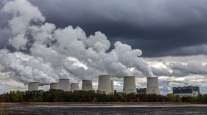Truck Emissions Much Lower Than Required, Study Says
Emissions of nitrogen dioxide and particulate matter from heavy-duty engines produced since 2010 are “substantially lower than required by regulations,” according to a new study.
The findings were reported by the Coordinating Research Council, a non-profit group that sponsors research on the environmental effects of petroleum use.
The group also said emissions of other potentially toxic but unregulated emissions, such as carbon monoxide and non-methane hydrocarbons, have also been substantially reduced.
“These findings underscore just how clean this new generation of fuels, engines and emissions control technology really is,” said Allen Schaeffer, executive director of the Diesel Technology Forum.
The study evaluated 2010 model engines from three different manufacturers, and found near zero emissions of fine particles and a 97% reduction in emissions of nitrogen dioxide compared with engines built before 2004.
“These findings ultimately translate into . . . significant clean air benefits for local communities,” said Schaeffer.
More than 11% of commercial trucks and buses are currently using the 2010 or newer diesel engines and more than one-third are using 2007 and newer engine technology, according the Diesel Technology Forum.
A final report on long-term health effects of exposure to diesel exhaust is expected to be released in the summer, CRC officials said.




